Mongol Empire
Great Mongol Nation ᠶᠡᠬᠡ ᠮᠣᠩᠭᠣᠯ ᠤᠯᠤᠰ Yeke Mongɣol Ulus ( Mongol | |||||||||||||
|---|---|---|---|---|---|---|---|---|---|---|---|---|---|
| Government |
| ||||||||||||
| Khagan-Emperor[note 2] | |||||||||||||
• 1206–1227 | Genghis Khan | ||||||||||||
• 1229–1241 | Ögedei Khan | ||||||||||||
• 1246–1248 | Güyük Khan | ||||||||||||
• 1251–1259 | Möngke Khan | ||||||||||||
• 1260–1294 | Kublai Khan (nominal) | ||||||||||||
• 1333–1368 | Toghon Temür (nominal) | ||||||||||||
| Area | |||||||||||||
| 1206[4] | 4,000,000 km2 (1,500,000 sq mi) | ||||||||||||
| 1227[4] | 12,000,000 km2 (4,600,000 sq mi) | ||||||||||||
| 1294[4] | 23,500,000 km2 (9,100,000 sq mi) | ||||||||||||
| |||||||||||||
The Mongol Empire of the 13th and 14th centuries was the largest contiguous empire in history.[5] Originating in present-day Mongolia in East Asia, the Mongol Empire at its height stretched from the Sea of Japan to parts of Eastern Europe, extending northward into parts of the Arctic;[6] eastward and southward into parts of the Indian subcontinent, attempted invasions of Southeast Asia, and conquered the Iranian Plateau; and westward as far as the Levant and the Carpathian Mountains.
The Mongol Empire emerged from the unification of several
The empire began to split due to wars over succession, as the grandchildren of Genghis Khan disputed whether the royal line should follow from his son and initial heir Ögedei or from one of his other sons, such as Tolui, Chagatai, or Jochi. The Toluids prevailed after a bloody purge of Ögedeid and Chagatayid factions, but disputes continued among the descendants of Tolui. The conflict over whether the Mongol Empire would adopt a sedentary, cosmopolitan lifestyle or stick to its nomadic, steppe-based way of life was a major factor in the breakup.
After
The part of the empire that fell first was the Ilkhanate, which disintegrated in the period of 1335–1353. Next, the Yuan dynasty lost control of the
Name
The Mongol Empire is also referred to as the "Mongolian Empire" or the "Mongol World Empire" in some English sources.[16][17] The empire referred to itself as ᠶᠡᠬᠡ
ᠮᠣᠩᠭᠣᠯ
ᠤᠯᠤᠰ yeke Mongγol ulus (lit. 'nation of the great Mongols' or the 'great Mongol nation') in Mongol or kür uluγ ulus (lit. the 'whole great nation') in Turkic.[18]
After 1260 to 1264 succession war between Kublai Khan and his brother Ariq Böke, Kublai's power became limited to the eastern part of the empire, centered on China. Kublai officially issued an imperial edict on 18 December 1271 to give the empire the Han-style dynastic name of "Great Yuan" (Dai Yuan, or Dai Ön Ulus'; Chinese: 大元; pinyin: Dà Yuán) and to establish the Yuan dynasty. Some sources give the full Mongol name as Dai Ön Yehe Monggul Ulus.[19]
History
Pre-empire context
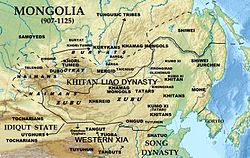
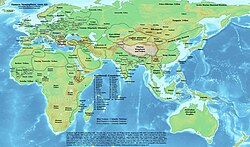
The area around
The
In 1147, the Jin somewhat changed their policy, signing a peace treaty with the Mongols and withdrawing from a score of forts. The Mongols then resumed attacks on the Tatars to avenge the death of their late khan, opening a long period of active hostilities. The Jin and Tatar armies defeated the Mongols in 1161.[20]
During the rise of the Mongol Empire in the 13th century, the usually cold, parched steppes of Central Asia enjoyed their mildest, wettest conditions in more than a millennium. It is thought that this resulted in a rapid increase in the number of war horses and other livestock, which significantly enhanced Mongol military strength.[21]
Rise of Genghis Khan
Known during his childhood as Temüjin, Genghis Khan was a son of a Mongol chieftain and rose very rapidly as a young man by working with Toghrul Khan of the Kerait. After Temujin went to war against Kurtait (also known as Wang Khan; given the Chinese title "Wang" for it's meaning of King[22]), who was the most powerful Mongol leader at the time, he gave himself the name Genghis Khan. He then enlarged[how?] his Mongol state under himself and his kin, with the term Mongol coming to be used in reference to all Mongolic speaking tribes under the control of Genghis Khan. His most powerful allies were his father's friend, Khereid chieftain Toghrul, and Temujin's childhood anda (i.e. blood brother) Jamukha of the Jadran clan. With their help, Temujin defeated the Merkit tribe, rescued his wife Börte, and went on to defeat the Naimans and the Tatars.[23]
Temujin forbade looting of his enemies without permission, and he implemented a policy of sharing spoils with his warriors and their families instead of giving it all to the aristocrats.[24] These policies brought him into conflict with his uncles, who were also legitimate heirs to the throne; they regarded Temujin not as a leader but as an insolent usurper. This dissatisfaction spread to his generals and other associates, and some Mongols who had previously been allies broke their allegiance.[23] War ensued, and Temujin and the forces still loyal to him prevailed, defeating the remaining rival tribes between 1203 and 1205 and bringing them under his sway. In 1206, Temujin was crowned as the khagan (Emperor) of the Yekhe Mongol Ulus (Great Mongol State) at a Kurultai (general assembly/council). It was there that he assumed the title of Genghis Khan (universal leader) instead of one of the old tribal titles such as Gur Khan or Tayang Khan, marking the start of the Mongol Empire.[23]
Early organization
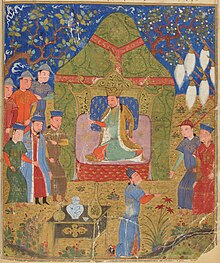
Genghis Khan introduced many innovative ways of organizing his army: for example dividing it into decimal subsections of arbans (10 soldiers), zuuns (100),
Compared to the units he gave to his loyal companions, those assigned to his own family members were relatively few. He proclaimed a new code of law of the empire,
He appointed his stepbrother
Push into Central Asia
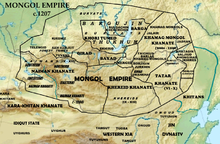
Genghis quickly came into conflict with the Jin dynasty of the Jurchens and the
Before his death, Genghis Khan divided his empire among his sons and immediate family, making the Mongol Empire the joint property of the entire imperial family who, along with the Mongol aristocracy, constituted the ruling class.[30]
Genghis Khan arranged for the Chinese Taoist master Qiu Chuji to visit him in Afghanistan, and also gave his subjects the right to religious freedom,[citation needed] despite his own shamanistic beliefs.
Death of Genghis Khan and expansion under Ögedei (1227–1241)
Genghis Khan died on 18 August 1227, by which time the Mongol Empire ruled from the Pacific Ocean to the
Among his first actions Ögedei sent troops to subjugate the Bashkirs, Bulgars, and other nations in the Kipchak-controlled steppes.[32] In the east, Ögedei's armies re-established Mongol authority in Manchuria, crushing the Eastern Xia regime and the Water Tatars. In 1230, the great khan personally led his army in the campaign against the Jin dynasty of China. Ögedei's general Subutai captured the capital of Emperor Wanyan Shouxu in the siege of Kaifeng in 1232.[33] The Jin dynasty collapsed in 1234 when the Mongols captured Caizhou, the town to which Wanyan Shouxu had fled. In 1234, three armies commanded by Ögedei's sons Kochu and Koten and the Tangut general Chagan invaded southern China. With the assistance of the Song dynasty the Mongols finished off the Jin in 1234.[34][35]
Many Han Chinese and Khitan defected to the Mongols to fight against the Jin. Two Han Chinese leaders, Shi Tianze, Liu Heima (劉黑馬, Liu Ni),[36] and the Khitan Xiao Zhala defected and commanded the 3 Tumens in the Mongol army.[37] Liu Heima and Shi Tianze served Ogödei Khan.[38] Liu Heima and Shi Tianxiang led armies against Western Xia for the Mongols.[39] There were four Han Tumens and three Khitan Tumens, with each Tumen consisting of 10,000 troops. The Yuan dynasty created a Han army 漢軍 from Jin defectors, and another of ex-Song troops called the Newly Submitted Army 新附軍.[40]
In the West Ögedei's general
In 1235, the Mongols established
Invasions of Kievan Rus' and central China
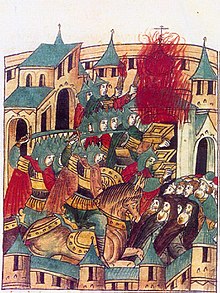
Meanwhile, in an offensive action against the
The Mongols captured the
They [the Mongols] attacked Russia, where they made great havoc, destroying cities and fortresses and slaughtering men; and they laid siege to Kiev, the capital of Russia; after they had besieged the city for a long time, they took it and put the inhabitants to death. When we were journeying through that land we came across countless skulls and bones of dead men lying about on the ground. Kiev had been a very large and thickly populated town, but now it has been reduced almost to nothing, for there are at the present time scarce two hundred houses there and the inhabitants are kept in complete slavery.[45]
Despite the military successes, strife continued within the Mongol ranks. Batu's relations with
Push into central Europe
The
Post-Ögedei power struggles (1241–1251)
Following the Great Khan Ögedei's death in 1241, and before the next kurultai, Ögedei's widow
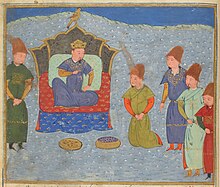
When Genghis Khan's youngest brother Temüge threatened to seize the throne, Güyük came to Karakorum to try to secure his position.[56] Batu eventually agreed to send his brothers and generals to the kurultai convened by Töregene in 1246. Güyük by this time was ill and alcoholic, but his campaigns in Manchuria and Europe gave him the kind of stature necessary for a great khan. He was duly elected at a ceremony attended by Mongols and foreign dignitaries from both within and without the empire — leaders of vassal nations, representatives from Rome, and other entities who came to the kurultai to show their respects and conduct diplomacy.[57][58]

Güyük took steps to reduce corruption, announcing that he would continue the policies of his father Ögedei, not those of Töregene. He punished Töregene's supporters, except for governor
Not all parts of the empire respected Güyük's election. The
Death of Güyük (1248)
In 1248, Güyük raised more troops and suddenly marched westward from the Mongol capital of Karakorum. The reasoning was unclear. Some sources wrote that he sought to recuperate at his personal estate, Emyl; others suggested that he might have been moving to join Eljigidei to conduct a full-scale conquest of the Middle East, or possibly to make a surprise attack on his rival cousin Batu Khan in Rus.[61]
Suspicious of Güyük's motives, Sorghaghtani Beki, the widow of Genghis's son Tolui, secretly warned her nephew Batu of Güyük's approach. Batu had himself been traveling eastward at the time, possibly to pay homage, or perhaps with other plans in mind. Before the forces of Batu and Güyük met, Güyük, sick and worn out by travel, died en route at Qum-Senggir (Hong-siang-yi-eulh) in Xinjiang, possibly a victim of poison.[61]
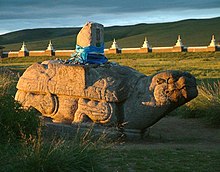
Güyük's widow Oghul Qaimish stepped forward to take control of the empire, but she lacked the skills of her mother-in-law Töregene, and her young sons Khoja and Naku and other princes challenged her authority. To decide on a new great khan, Batu called a kurultai on his own territory in 1250. As it was far from the Mongol heartland, members of the Ögedeid and Chagataid families refused to attend. The kurultai offered the throne to Batu, but he rejected it, claiming he had no interest in the position.[62] Batu instead nominated Möngke, a grandson of Genghis from his son Tolui's lineage. Möngke was leading a Mongol army in Rus, the northern Caucasus and Hungary. The pro-Tolui faction supported Batu's choice, and Möngke was elected; though given the kurultai's limited attendance and location, it was of questionable validity.[62]
Batu sent Möngke, under the protection of his brothers,
Rule of Möngke Khan (1251–1259)
When Möngke's mother Sorghaghtani and their cousin Berke organized a second kurultai on 1 July 1251, the assembled throng proclaimed Möngke great khan of the Mongol Empire. This marked a major shift in the leadership of the empire, transferring power from the descendants of Genghis's son Ögedei to the descendants of Genghis's son Tolui. The decision was acknowledged by a few of the Ögedeid and Chagataid princes, such as Möngke's cousin Kadan and the deposed khan Qara Hülëgü, but one of the other legitimate heirs, Ögedei's grandson Shiremun, sought to topple Möngke.[63]
Shiremun moved with his own forces toward the emperor's nomadic palace with a plan for an armed attack, but Möngke was alerted by his falconer of the plan. Möngke ordered an investigation of the plot, which led to a series of major trials all across the empire. Many members of the Mongol elite were found guilty and put to death, with estimates ranging from 77 to 300, though princes of Genghis's royal line were often exiled rather than executed.[63]
Möngke confiscated the estates of the Ögedeid and the Chagatai families and shared the western part of the empire with his ally Batu Khan. After the bloody purge, Möngke ordered a general amnesty for prisoners and captives, but thereafter the power of the great khan's throne remained firmly with the descendants of Tolui.[63]
Administrative reforms
Möngke was a serious man who followed the laws of his ancestors and avoided alcoholism. He was tolerant of outside religions and artistic styles, leading to the building of foreign merchants' quarters,
Although he had a strong Chinese contingent, Möngke relied heavily on Muslim and Mongol administrators and launched a series of economic reforms to make government expenses more predictable. His court limited government spending and prohibited nobles and troops from abusing civilians or issuing edicts without authorization. He commuted the contribution system to a fixed poll tax which was collected by imperial agents and forwarded to units in need.
In another move to consolidate his power, Möngke assigned his brothers
Kublai conquered the Dali Kingdom in 1253 after the Dali King Duan Xingzhi defected to the Mongols and helped them conquer the rest of Yunnan. Möngke's general Qoridai stabilized his control over Tibet, inducing leading monasteries to submit to Mongol rule. Subutai's son Uryankhadai reduced the neighboring peoples of Yunnan to submission and went to war with the kingdom of Đại Việt under the Trần dynasty in northern Vietnam in 1258, but they had to draw back.[59] The Mongol Empire tried to invade Đại Việt again in 1285 and 1287 but were defeated both times.
New invasions of the Middle East and Southern China

After stabilizing the empire's finances, Möngke once again sought to expand its borders. At kurultais in Karakorum in 1253 and 1258 he approved new invasions of the Middle East and south China. Möngke put Hulagu in overall charge of military and civil affairs in Persia, and appointed Chagataids and Jochids to join Hulagu's army.[66]
The Muslims from
The center of the Islamic Empire at the time was Baghdad, which had held power for 500 years but was suffering internal divisions. When its caliph
His army advanced toward
Death of Möngke Khan (1259)
Meanwhile, in the northwestern portion of the empire, Batu's successor and younger brother Berke sent punitive expeditions to Ukraine, Belarus, Lithuania and Poland. Dissension began brewing between the northwestern and southwestern sections of the Mongol Empire as Batu suspected that Hulagu's invasion of Western Asia would result in the elimination of Batu's own dominance there.[68]
In the southern part of the empire, Möngke Khan himself led his army, but did not complete the conquest of China. Military operations were generally successful, but prolonged, so the forces did not withdraw to the north as was customary when the weather turned hot. Disease ravaged the Mongol forces with bloody epidemics, and Möngke died there on 11 August 1259. This event began a new chapter in the history of the Mongols, as again a decision needed to be made on a new great khan. Mongol armies across the empire withdrew from their campaigns to convene a new kurultai.[69]
Disunity
Dispute over succession
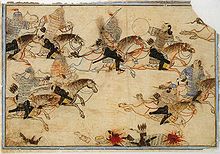
Möngke's brother Hulagu broke off his successful military advance into Syria, withdrawing the bulk of his forces to
In 1260, the Mamluks advanced from Egypt, being allowed to camp and resupply near the Christian stronghold of Acre, and engaged Kitbuqa's forces just north of Galilee at the Battle of Ain Jalut. The Mongols were defeated, and Kitbuqa executed. This pivotal battle marked the western limit for Mongol expansion in the Middle East, and the Mongols were never again able to make serious military advances farther than Syria.[70]
In a separate part of the empire,
Mongol Civil War
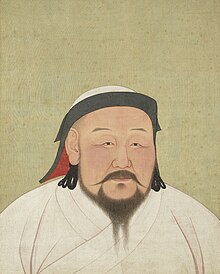
Battles ensued between the armies of Kublai and those of his brother Ariqboke, which included forces still loyal to Möngke's previous administration. Kublai's army easily eliminated Ariqboke's supporters and seized control of the civil administration in southern Mongolia. Further challenges took place from their cousins, the Chagataids.[71][72][73] Kublai sent Abishka, a Chagataid prince loyal to him, to take charge of Chagatai's realm. But Ariqboke captured and then executed Abishka, having his own man Alghu crowned there instead. Kublai's new administration blockaded Ariqboke in Mongolia to cut off food supplies, causing a famine. Karakorum fell quickly to Kublai, but Ariqboke rallied and re-took the capital in 1261.[71][72][73]
In southwestern Ilkhanate, Hulagu was loyal to his brother Kublai, but clashes with their cousin Berke, a Muslim and the ruler of the Golden Horde, began in 1262. The suspicious deaths of Jochid princes in Hulagu's service, unequal distribution of war booty, and Hulagu's massacres of Muslims increased the anger of Berke, who considered supporting a rebellion of the Georgian Kingdom against Hulagu's rule in 1259–1260.[74][full citation needed] Berke also forged an alliance with the Egyptian Mamluks against Hulagu and supported Kublai's rival claimant, Ariqboke.[75]
Hulagu died on 8 February 1264. Berke sought to take advantage and invade Hulagu's realm, but he died along the way, and a few months later Alghu Khan of the Chagatai Khanate died as well. Kublai named Hulagu's son
Campaigns of Kublai Khan (1264–1294)
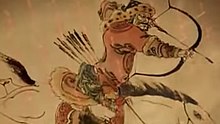
In the south, after
The Mongols were eventually successful in their campaigns against (Song) China, and the Chinese
After achieving actual or nominal dominion over much of Eurasia and successfully conquering China, Kublai pursued further expansion. His invasions of Burma and Sakhalin were costly, and his attempted invasions of Đại Việt (northern Vietnam) and Champa (southern Vietnam) ended in devastating defeat, but secured vassal statuses of those countries. The Mongol armies were repeatedly beaten in Đại Việt and were crushed at the Battle of Bạch Đằng (1288).
Nogai and Konchi, the khan of the White Horde, established friendly relations with the Yuan dynasty and the Ilkhanate. Political disagreement among contending branches of the family over the office of great khan continued, but the economic and commercial success of the Mongol Empire continued despite the squabbling.[81][82][83]
In 1274 and again in 1281, Kublai Khan invaded Japan on two separate occasions. However, he was not able to conquer Japan. In the period of the Mongol invasion, the battles of Bun'ei and Kōan were fought along the coast of Hakata Bay near modern-day Fukuoka.
Disintegration into competing entities

Major changes occurred in the Mongol Empire in the late 1200s. Kublai Khan, after having conquered all of China and established the Yuan dynasty, died in 1294. He was succeeded by his grandson Temür Khan, who continued Kublai's policies. At the same time the Toluid Civil War, along with the Berke–Hulagu war and the subsequent Kaidu–Kublai war, greatly weakened the authority of the great khan over the entirety of the Mongol Empire and the empire fractured into autonomous khanates, the Yuan dynasty and the three western khanates: the Golden Horde, the Chagatai Khanate and the Ilkhanate. Only the Ilkhanate remained loyal to the Yuan court but endured its own power struggle, in part because of a dispute with the growing Islamic factions within the southwestern part of the empire.[84]
After the death of Kaidu, the Chatagai ruler Duwa initiated a peace proposal and persuaded the Ögedeids to submit to Temür Khan.[85][86] In 1304, all of the khanates approved a peace treaty and accepted Yuan emperor Temür's supremacy.[87][88][89][90] This established the nominal supremacy of the Yuan dynasty over the western khanates, which was to last for several decades. This supremacy was based on weaker foundations than that of the earlier Khagans and each of the four khanates continued to develop separately and function as independent states.
Nearly a century of conquest and civil war was followed by relative stability, the Pax Mongolica, and international trade and cultural exchanges flourished between Asia and Europe. Communication between the Yuan dynasty in China and the Ilkhanate in Persia further encouraged trade and commerce between east and west. Patterns of Yuan royal textiles could be found on the opposite side of the empire adorning Armenian decorations; trees and vegetables were transplanted across the empire; and technological innovations spread from Mongol dominions toward the West.[91] Pope John XXII was presented a memorandum from the eastern church describing the Pax Mongolica: "... Khagan is one of the greatest monarchs and all lords of the state, e.g., the king of Almaligh (Chagatai Khanate), emperor Abu Said and Uzbek Khan, are his subjects, saluting his holiness to pay their respects."[92] However, while the four khanates continued to interact with one another well into the 14th century, they did so as sovereign states and never again pooled their resources in a cooperative military endeavor.[93]
Development of the khanates


In spite of his conflicts with Kaidu and Duwa, Yuan emperor Temür established a tributary relationship with the war-like Shan people after his series of military operations against Thailand from 1297 to 1303. This was to mark the end of the southern expansion of the Mongols.
When Ghazan took the throne of the Ilkhanate in 1295, he formally accepted Islam as his own religion, marking a turning point in Mongol history after which Mongol Persia became more and more Islamic. Despite this, Ghazan continued to strengthen ties with Temür Khan and the Yuan dynasty in the east. It was politically useful to advertise the great khan's authority in the Ilkhanate, because the Golden Horde in Rus had long made claims on nearby Georgia.[84] Within four years, Ghazan began sending tribute to the Yuan court and appealing to other khans to accept Temür Khan as their overlord. He oversaw an extensive program of cultural and scientific interaction between the Ilkhanate and the Yuan dynasty in the following decades.[95]
Ghazan's faith may have been Islamic, but he continued his ancestors' war with the Egyptian Mamluks, and consulted with his old Mongol advisers in his native tongue. He defeated the Mamluk army at the
Struggling for influence within the Golden Horde, Kaidu sponsored his own candidate Kobeleg against
Duwa was challenged by Kaidu's son Chapar, but with the assistance of Temür, Duwa defeated the Ögedeids.
In the Chagatai Khanate,
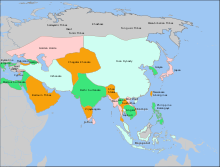
Tugh Temür (1304–32) was knowledgeable about Chinese language and history and was also a creditable poet, calligrapher, and painter. In order to be accepted by other khanates as the sovereign of the Mongol world, he sent Genghisid princes and descendants of notable Mongol generals to the Chagatai Khanate, Ilkhan Abu Said, and Ozbeg. In response to the emissaries, they all agreed to send tribute each year.[100] Furthermore, Tugh Temür gave lavish presents and an imperial seal to Eljigidey to mollify his anger.
Rump states of the Mongol Empire

With the death of Ilkhan
As the power of the Mongols declined, chaos erupted throughout the empire as non-Mongol leaders expanded their own influence. The Golden Horde lost all of its western dominions (including modern
However, rival families of the Jochids began fighting for the throne of the Golden Horde (
Increasingly isolated from their subjects, the Mongols quickly lost most of China to the rebellious Ming forces and in 1368 fled to their heartland in Mongolia. After the overthrow of the Yuan dynasty the Golden Horde lost touch with Mongolia and China, while the two main parts of the Chagatai Khanate were defeated by Timur (Tamerlane) (1336–1405), who founded the Timurid Empire. However, remnants of the Chagatai Khanate survived; the last Chagataid state to survive was the Yarkent Khanate, until its defeat by the Oirat Dzungar Khanate in the Dzungar conquest of Altishahr in 1680. The Golden Horde broke into smaller Turkic-hordes that declined steadily in power over four centuries. Among them, the khanate's shadow, the Great Horde, survived until 1502, when one of its successors, the Crimean Khanate, sacked Sarai.[106] The Crimean Khanate lasted until 1783, whereas khanates such as the Khanate of Bukhara and the Kazakh Khanate lasted even longer.
Military organization

The number of troops mustered by the Mongols is the subject of some scholarly debate,[107] but was at least 105,000 in 1206.[108] The Mongol military organization was simple but effective, based on the decimal system. The army was built up from squads of ten men each, arbans (10 people), zuuns (100), Mingghans (1000), and tumens (10,000).[109]
The Mongols were most famous for their horse archers, but troops armed with lances were equally skilled, and the Mongols recruited other military specialists from the lands they conquered. With experienced Chinese engineers and a bombardier corps which was expert at building trebuchets, catapults and other machines, the Mongols could lay siege to fortified positions, sometimes building machinery on the spot using available local resources.[109]

Forces under the command of the Mongol Empire were trained, organized, and equipped for mobility and speed. Mongol soldiers were more lightly armored than many of the armies they faced but were able to make up for it with maneuverability. Each Mongol warrior would usually travel with multiple horses, allowing him to quickly switch to a fresh mount as needed. In addition, soldiers of the Mongol army functioned independently of
Discipline was inculcated during a nerge (traditional hunt), as reported by
Another advantage of the Mongols was their ability to traverse large distances, even in unusually cold winters; for instance, frozen rivers led them like highways to large urban centers on their banks. The Mongols were adept at river-work, crossing the river
Traditionally known for their prowess with ground forces, the Mongols rarely used naval power. In the 1260s and 1270s they used seapower while conquering the Song dynasty of China, though their attempts to mount seaborne campaigns against Japan were unsuccessful. Around the Eastern Mediterranean, their campaigns were almost exclusively land-based, with the seas controlled by the Crusader and Mamluk forces.[111]
All military campaigns were preceded by careful planning, reconnaissance, and the gathering of sensitive information relating to enemy territories and forces. The success, organization, and mobility of the Mongol armies permitted them to fight on several fronts at once. All adult males up to the age of 60 were eligible for conscription into the army, a source of honor in their tribal warrior tradition.[112]
Society
Law and governance

The Mongol Empire was governed by a code of law devised by Genghis, called Yassa, meaning "order" or "decree". A particular canon of this code was that those of rank shared much the same hardship as the common man. It also imposed severe penalties, e.g., the death penalty if one mounted soldier following another did not pick up something dropped from the mount in front. Penalties were also decreed for rape and to some extent for murder. Any resistance to Mongol rule was met with massive collective punishment. Cities were destroyed and their inhabitants slaughtered if they defied Mongol orders.[citation needed] Under Yassa, chiefs and generals were selected based on merit. The empire was governed by a non-democratic, parliamentary-style central assembly, called kurultai, in which the Mongol chiefs met with the great khan to discuss domestic and foreign policies. Kurultais were also convened for the selection of each new great khan.[113]
Genghis Khan also created a national seal, encouraged the use of a written alphabet in Mongolia, and exempted teachers, lawyers, and artists from taxes.[citation needed]
The Mongols imported Central Asian Muslims to serve as administrators in China and sent Han Chinese and Khitans from China to serve as administrators over the Muslim population in Bukhara in Central Asia, thus using foreigners to curtail the power of the local peoples of both lands.[114] The Mongols were tolerant of other religions, and rarely persecuted people on religious grounds. Some historians of the 20th century thought this was a good military strategy: when Genghis was at war with Sultan Muhammad of Khwarezm, other Islamic leaders did not join the fight, as it was seen as a non-holy war between two individual powers.[citation needed]
Religions
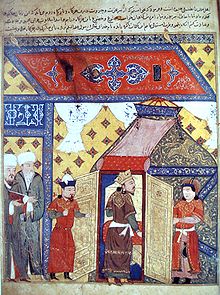
At the time of Genghis Khan, virtually every religion had found Mongol converts, from Buddhism to Christianity, from Manichaeism to Islam. To avoid strife, Genghis Khan set up an institution that ensured complete religious freedom, though he himself was a shamanist. Under his administration, all religious leaders were exempt from taxation and from public service.[115]
Initially there were few formal places of worship because of the nomadic lifestyle. However, under Ögedei (1186–1241), several building projects were undertaken in the Mongol capital. Along with palaces, Ögedei built houses of worship for the Buddhist, Muslim, Christian, and Taoist followers. The dominant religions at that time were Tengrism and Buddhism, although Ögedei's wife was a Nestorian Christian.[116]
Eventually, each of the successor states adopted the dominant religion of the local populations: the Mongol-ruled Chinese Yuan dynasty in the East (originally the Great Khan's domain) embraced Buddhism and Shamanism, while the three Western khanates adopted Islam.[117][118][119]
Arts and literature
The oldest surviving literary work in the
Another classic from the empire is the Jami' al-tawarikh, or "Universal History". It was commissioned in the early 14th century by the Ilkhan Abaqa Khan as a way of documenting the entire world's history, to help establish the Mongols' own cultural legacy.
Mongol scribes in the 14th century used a mixture of resin and vegetable pigments as a primitive form of correction fluid;[120] this is arguably its first known usage.
The Mongols also appreciated the visual arts, though their taste in portraiture was strictly focused on portraits of their horses, rather than of people.[citation needed]
Science
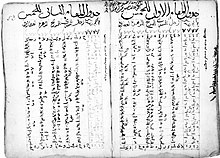
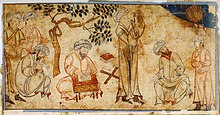
The Mongol Empire saw some significant developments in science due to the patronage of the Khans. Roger Bacon attributed the success of the Mongols as world conquerors principally to their devotion to mathematics.
Kublai Khan built a number of large observatories in China and his libraries included the Wu-hu-lie-ti (Euclid) brought by Muslim mathematicians.[124] Zhu Shijie and Guo Shoujing were notable mathematicians in Yuan China. The Mongol physician Hu Sihui described the importance of a healthy diet in a 1330 medical treatise.
Mail system

The Mongol Empire had an ingenious and efficient mail system for the time, often referred to by scholars as the Yam. It had lavishly furnished and well-guarded relay posts known as örtöö set up throughout the Empire.[126] A messenger would typically travel 40 kilometres (25 miles) from one station to the next, either receiving a fresh, rested horse, or relaying the mail to the next rider to ensure the speediest possible delivery. The Mongol riders regularly covered 200 km (125 mi) per day, better than the fastest record set by the Pony Express some 600 years later.[citation needed] The relay stations had attached households to service them. Anyone with a paiza was allowed to stop there for re-mounts and specified rations, while those carrying military identities used the Yam even without a paiza. Many merchants, messengers, and travelers from China, the Middle East, and Europe used the system. When the great khan died in Karakorum, news reached the Mongol forces under Batu Khan in Central Europe within 4–6 weeks thanks to the Yam.[50]
Genghis and his successor
Kublai Khan, founder of the Yuan dynasty, built special relays for high officials, as well as ordinary relays, that had hostels. During Kublai's reign, the Yuan communication system consisted of some 1,400 postal stations, which used 50,000 horses, 8,400 oxen, 6,700 mules, 4,000 carts, and 6,000 boats.[citation needed]
In
Silk Road
The Mongols had a history of supporting merchants and trade. Genghis Khan had encouraged foreign merchants early in his career, even before uniting the Mongols. Merchants provided information about neighboring cultures, served as diplomats and official traders for the Mongols, and were essential for many goods, since the Mongols produced little of their own.
Mongol government and elites provided capital for merchants and sent them far afield, in an ortoq (merchant partner) arrangement. In Mongol times, the contractual features of a Mongol-ortoq partnership closely resembled that of qirad and commenda arrangements, however, Mongol investors were not constrained using uncoined precious metals and tradable goods for partnership investments and primarily financed money-lending and trade activities.[128] Moreover, Mongol elites formed trade partnerships with merchants from Italian cities, including Marco Polo’s family.[129] As the empire grew, any merchants or ambassadors with proper documentation and authorization received protection and sanctuary as they traveled through Mongol realms. Well-traveled and relatively well-maintained roads linked lands from the Mediterranean basin to China, greatly increasing overland trade and resulting in some dramatic stories of those who travelled through what would become known as the Silk Road.
Western explorer Marco Polo traveled east along the Silk Road, and the Chinese Mongol monk Rabban Bar Sauma made a comparably epic journey along the route, venturing from his home of Khanbaliq (Beijing) as far as Europe. European missionaries, such as William of Rubruck, also traveled to the Mongol court to convert believers to their cause, or went as papal envoys to correspond with Mongol rulers in an attempt to secure a Franco-Mongol alliance. It was rare, however, for anyone to journey the full length of Silk Road. Instead, merchants moved products like a bucket brigade, goods being traded from one middleman to another, moving from China all the way to the West; the goods moved over such long distances fetched extravagant prices.[citation needed]

After Genghis, the merchant partner business continued to flourish under his successors Ögedei and Güyük. Merchants brought clothing, food, information, and other provisions to the imperial palaces, and in return the great khans gave the merchants tax exemptions and allowed them to use the official relay stations of the Mongol Empire. Merchants also served as tax farmers in China, Rus and Iran. If the merchants were attacked by bandits, losses were made up from the imperial treasury.[citation needed]
Policies changed under the Great Khan Möngke. Because of money laundering and overtaxing, he attempted to limit abuses and sent imperial investigators to supervise the ortoq businesses. He decreed that all merchants must pay commercial and property taxes, and he paid off all drafts drawn by high-ranking Mongol elites from the merchants. This policy continued under the Yuan dynasty.[citation needed]
The fall of the Mongol Empire in the 14th century led to the collapse of the political, cultural, and economic unity along the Silk Road. Turkic tribes seized the western end of the route from the
Legacy

The Mongol Empire, at its height of the largest contiguous empire in history, had a lasting impact, unifying large regions. Some of these (such as eastern and western Russia, and the western parts of China) remain unified today.
According to some[specify] interpretations, Genghis Khan's conquests caused wholesale destruction on an unprecedented scale in certain geographic regions, leading to changes in the demographics of Asia.
The non-military achievements of the Mongol Empire include the introduction of a writing system, a Mongol alphabet based on the characters of the Old Uyghur, which is still used in Mongolia today.[132]

Some of the other long-term consequences of the Mongol Empire include:
- Moscow rose to prominence while it was still under the Grand Duchy of Moscowgained independence.
- Europe's knowledge of the known world was immensely expanded by the information which was brought back to it by ambassadors and merchants. When Columbus sailed in 1492, his mission was to reach Cathay, the land of the Grand Khan in China, and give him a letter from the monarchs Ferdinand II of Aragon and Isabella I of Castile.[citation needed]
- Some studies indicate that the biological weapon. The corpses were catapulted over the city walls, infecting the inhabitants.[133][134] The Genoese traders fled, transferring the plague via their ships into the south of Europe, from where it rapidly spread. The total number of deaths worldwide from the pandemic is estimated at 75–200 million with up to 50 million deaths in Europe alone.[135]

- Western researcher R. J. Rummel estimated that 30 million people were killed by the Mongol Empire. Other researchers estimate that as many as 80 million people were killed, with 50 million deaths being the middle ground. The population of China fell by half during fifty years of Mongol rule. Before the Mongol invasion, the territories of the Chinese dynasties reportedly had approximately 120 million inhabitants; after the conquest was completed in 1279, the 1300 census reported that China's total population was roughly 60 million. While it is tempting to attribute this major decline in China's population solely to Mongol ferocity, today scholars have mixed opinions about this subject. Scholars such as Frederick W. Mote argue that the wide drop in numbers reflects an administrative failure to keep records rather than a de facto decrease, while others such as Timothy Brook argue that the Mongols reduced much of the south Chinese population, and very debatably the Han Chinese population, to an invisible status through cancellation of the right to passports and denial of the right to direct land ownership. This meant that the Chinese had to depend on and be cared for chiefly by Mongols and Tartars, which also involved recruitment into the Mongol army. Other historians such as William McNeill and David O. Morgan argue that the bubonic plague was the main factor behind China's demographic decline during this period.[citation needed]
- The Islamic world was subjected to massive changes as a result of the Mongol invasions. The population of the Iranian plateau suffered from widespread disease and famine, resulting in the death of up to three-quarters of its population, possibly 10 to 15 million people. Historian Steven Ward estimates that Iran's population did not reach its pre-Mongol levels again until the mid-20th century.[136]
- Mesopotamia, for millennia a showplace and pinnacle of human civilization and achievement, was depopulated and pastoralized, never to resume its previous pre-eminence. In his H.G. Wellsattributed this to a Mongol prejudice against urban life:
[I]n this region [Mesopotamia] nomadism really did attempt, and really did to a very considerable degree succeed in its attempt, to stamp a settled civilized system out of existence. When Jengis Khan first invaded China, we are told that there was a serious discussion among the Mongol chiefs whether all the towns and settled populations should not be destroyed. To these simple practitioners of the open-air life the settled populations seemed corrupt, crowded, vicious, effeminate, dangerous, and incomprehensible; a detestable human efflorescence upon what would otherwise have been good pasture. They had no use whatever for the towns. **** But it was only under Hulagu in Mesopotamia that these ideas seem to have been embodied in a deliberate policy. The Mongols here did not only burn and massacre; they destroyed the irrigation system that had endured for at least eight thousand years, and with that the mother civilization of all the Western world came to an end.[137]
- David Nicole states in The Mongol Warlords, "terror and mass extermination of anyone opposing them was a well tested Mongol tactic."Rogerius, an eyewitness, said that "the Mongols killed everybody regardless of gender or age" and "the Mongols especially 'found pleasure' in humiliating women."[141]
- One of the more successful tactics employed by the Mongols was to wipe out urban populations that refused to surrender. During the Mongol invasion of Rus', almost all major cities were destroyed. If they chose to submit, the people were generally spared, though this was not guaranteed. For example, the city of Hamadan in modern-day Iran was destroyed and every man, woman, and child executed by Mongol general Subadai, after surrendering to him but failing to have enough provisions for his Mongol scouting force. Several days after the initial razing of the city, Subadai sent a force back to the burning ruins and the site of the massacre to kill any inhabitants of the city who had been away at the time of the initial slaughter and had returned in the meantime. Mongol armies made use of local peoples and their soldiers, often incorporating them into their armies. Prisoners of war sometimes were given the choice between death and becoming part of the Mongol army to aid in future conquests. Due to the brutal methods employed to subdue their subjects, Mongols maintained long lasting resentment from those they conquered. This resentment towards the Mongol rule has been highlighted as a cause for the empire's rapid fracturing.[142] In addition to intimidation tactics, the rapid expansion of the empire was facilitated by military hardiness (especially during bitterly cold winters), military skill, meritocracy, and discipline.
- The
See also
- Mughal-Mongol genealogy
- Tellurocracy
- Xiongnu origin of Mongol
- Destruction under the Mongol Empire
- Mongol dynasty (disambiguation)
- Mongol khanate (disambiguation)
- Göktürk Khaganate
- Mongolization
- List of Mongol states
- List of medieval Mongol tribes and clans
Explanatory notes
- ^ Especially western Kipchak dialects in the Golden Horde,[1] Chagatai in the Chagatai Khanate[2] and Old Uyghur in the Yuan dynasty.
- ^ Decades before Kublai Emperor announced the dynastic name "Great Yuan" in 1271, khagans (Great Khans) of the "Great Mongol State" (Yeke Mongγol Ulus) already started to use the Chinese title of Emperor (Chinese: 皇帝; pinyin: Huángdì) practically in the Chinese language since the enthronement of Genghis Emperor (成吉思皇帝; 'Chéngjísī Huángdì') in Spring 1206.[3]
- ^ As per modern historiographical norm, the "Yuan dynasty" in this article refers exclusively to the realm based in Dadu (present-day Beijing). However, the Han-style dynastic name "Great Yuan" (大元) as proclaimed by Kublai, as well as the claim to Chinese political orthodoxy were meant to be applied to the entire Mongol Empire.[9][10][11][12] In spite of this, "Yuan dynasty" is rarely used in the broad sense of the definition by modern scholars due to the de facto disintegrated nature of the Mongol Empire.
References
Citations
- ISBN 978-90-04-19190-7 – via Google Books.
- .
- ^ 太祖本纪 [Chronicle of Taizu]. 元史 [History of Yuan] (in Literary Chinese).
元年丙寅,帝大会诸王群臣,建九斿白旗,即皇帝位于斡难河之源,诸王群臣共上尊号曰成吉思皇帝。
[In the first year of Bingyin [1206], the emperor gathered all the kings and ministers to build the Jiumai White Banner, that is, the emperor was located at the source of the Onan River, and all the kings and ministers honored him as Emperor Genghis.] - ^ from the original on 19 November 2018. Retrieved 8 December 2018.
- ^ Morgan. The Mongols. p. 5.
- ^ Pow, Stephen (6 April 2020). "The Mongol Empire's Northern Border: Re-evaluating the Surface Area of the Mongol Empire". Genius Loci – Laszlovszky 60. Archived from the original on 29 September 2021. Retrieved 6 April 2020.
- ^ "The Islamic World to 1600: The Golden Horde". University of Calgary. 1998. Archived from the original on 13 November 2010. Retrieved 3 December 2010.
- ISBN 0-7007-0631-3.
- ^ Kublai (18 December 1271), 《建國號詔》 [Edict to Establish the Name of the State], 《元典章》[Statutes of Yuan] (in Classical Chinese)
- ISBN 9781108482448. Archived from the original on 6 October 2022. Retrieved 18 March 2022 – via Google Books.
- ISBN 9780674036086. Archived from the original on 6 October 2022. Retrieved 18 March 2022 – via Google Books.
- ISBN 9780226562933 – via Google Books.
- ^ The Cambridge History of China: Alien Regimes and Border States. p. 413.
- ^ Jackson. Mongols and the West. p. 127.
- ^ Allsen. Culture and Conquest. pp. xiii, 235.
- ISBN 9781139054744. Archivedfrom the original on 7 September 2023. Retrieved 7 September 2023.
- ISBN 9781538111376.
- ^ Igor de Rachewiltz; Volker Rybatzki (2010). Introduction to Altaic Philology: Turkic, Mongolian, Manchu. p. 169.
- ^ Rybatzki. p. 116.
- ^ a b c Barfield. p. 184.
- PMID 24616521.
- ^ E.D. Philips The Mongols p. 37
- ^ a b c d Morgan. The Mongols. pp. 49–73.
- ^ Riasanovsky. Fundamental Principles of Mongol law. p. 83.
- ^ Ratchnevsky. p. 191.
- ^ a b Secret history. p. 203.
- ^ Vladimortsov. p. 74.
- ^ Weatherford 2004, p. 70.
- ^ Man, John (2004). Genghis Khan: Life, Death, and Resurrection. New York: Thomas Dunne Books. p. 116.
- ^ Morgan. pp. 99–101.
- ^ Man. Genghis Khan. p. 288.
- ^ Saunders 2001, p. 81.
- ^ Atwood 2004, p. 277.
- ^ Rossabi 1983, p. 221.
- ^ Atwood 2004, p. 509.
- ^ Collectif 2002 Archived 16 September 2015 at the Wayback Machine, p. 147.
- ^ May 2004 Archived 22 September 2015 at the Wayback Machine, p. 50.
- ^ Schram 1987 Archived 17 October 2015 at the Wayback Machine, p. 130.
- ^ eds. Seaman, Marks 1991 Archived 21 September 2015 at the Wayback Machine, p. 175.
- ^ Hucker 1985 Archived 10 September 2015 at the Wayback Machine, p. 66.
- ^ May. Chormaqan. p. 29.
- ^ Amitai. The Mamluk-Ilkhanid war
- ^ Grousset. p. 259.
- ^ a b Timothy May. Chormaqan. p. 32.
- ^ "The Destruction of Kiev". Tspace.library.utoronto.ca. Archived from the original on 19 August 2016. Retrieved 12 October 2013.
- ^ Jackson. Delhi Sultanate. p. 105.
- ^ Bor. p. 186.
- ^ Atwood 2004, p. 297.
- ^ Henthorn, William E. (1963). Korea: the Mongol invasions. E.J. Brill. pp. 160, 183. Archived from the original on 15 March 2016. Retrieved 13 March 2017.
- ^ a b Weatherford 2004, p. 158.
- J. A. Giles). p. 348.
- ^ a b Morgan. The Mongols. p. 104.
- ISBN 978-3-030-00727-0
- from the original on 10 January 2021.
- ^ a b Jackson. Mongols and the West. p. 95.
- ^ The Academy of Russian science and the academy of Mongolian science Tataro-Mongols in Europe and Asia. p. 89.
- ^ Weatherford 2004, p. 163.
- ^ Man. Kublai Khan. p. 28.
- ^ a b c d e Atwood 2004, p. 255.
- ^ Weatherford 2004, p. 179.
- ^ a b Atwood 2004, p. 213.
- ^ a b c Morgan. The Mongols. p. 159.
- ^ a b c Morgan. The Mongols. pp. 103–04.
- S2CID 144625106.
- ^ a b Allsen. Mongol Imperialism. p. 280.
- ^ a b Morgan. The Mongols. p. 129.
- ^ a b Morgan. The Mongols. pp. 132–35.
- ^ Morgan. The Mongols. pp. 127–28.
- ^ Lane. p. 9.
- ^ a b Morgan. The Mongols. p. 138.
- ^ a b Wassaf. p. 12.[full citation needed]
- ^ a b Jackson. Mongols and the West. p. 109.
- ^ a b Barthold. Turkestan. p. 488.
- ^ L. N.Gumilev, A. Kruchki. Black legend
- ^ Barthold. Turkestan Down to the Mongol Invasion. p. 446.
- ^ Prawdin. Mongol Empire and Its Legacy. p. 302.
- ^ Weatherford 2004, p. 120.
- ^ Man. Kublai Khan. p. 74.
- ^ Sh.Tseyen-Oidov – Ibid. p. 64.
- ^ Man. Kublai Khan. p. 207.
- ^ Weatherford 2004, p. 195.
- ^ Vernadsky 1953, pp. 344–66.
- ^ Henryk Samsonowicz, Maria Bogucka. A Republic of Nobles. p. 179.[full citation needed]
- ^ a b Prawdin (1961)[page needed]
- ^ d.Ohson. History of the Mongols. p. II. p. 355.[full citation needed]
- ^ Sh.Tseyen-Oidov. Genghis bogdoos Ligden khutagt khurtel (khaad). p. 81.[full citation needed]
- ^ Vernadsky 1953, p. 74.
- ^ Oljeitu's letter to Philipp the Fair
- ^ Saunders 2001.
- ^ Howorth. p. 145.
- ^ Weatherford 2004, p. 236.
- ^ Vernadsky 1953, p. 93.
- ^ Franke 1994, p. 413.
- ^ Bibliothèque nationale de France. Département des Manuscrits. Division occidentale. Nouvelle acquisition française 886, fol. 37v
- ^ Allsen. Culture and Conquest. pp. 32–35.
- ^ René Grousset. The Empire of the Steppes
- ^ Atwood 2004, p. 445.
- ^ Atwood 2004, p. 106.
- ^ Allsen. Culture and Conquest. p. 39.
- ^ Franke 1994, pp. 541–550.
- )
- ^ Getz, Trevor. "READ: Unit 3 Introduction – Land-Based Empires 1450 to 1750". Khan Academy. Retrieved 19 April 2024.
- ^ Morgan. The Mongols. pp. 117–18.
- ^ Ole Jørgen Benedictow, The Black Death, 1346–1353: The Complete History (2004), p. 382.p. 382. Archived 17 October 2015 at the Wayback Machine
- ^ a b Prawdin 1961, p. 379.
- ^ Halperin. p. 28.
- ^ Sverdrup. p. 109.
- ^ Sverdrup. p. 110.
- ^ a b Morgan. The Mongols. pp. 80–81.
- ^ a b Morgan. The Mongols. pp. 74–75
- ^ Morgan. Mongols and the Eastern Mediterranean
- ^ Morgan. The Mongols. p. 75
- ^ San, T. "Dynastic China: An Elementary History" .pg 297
- JSTOR 41930343.
- ^ Weatherford 2004, p. 69.
- ^ Weatherford 2004, p. 135.
- ^ a b Foltz. pp. 105–06.
- ^ Ezzati. The Spread of Islam: The Contributing Factors. p. 274.
- ^ Bukharaev. Islam in Russia: The Four Seasons. p. 145.
- ^ Hull. The Mongol Empire. p. 60
- ISBN 978-90-04-15575-6.
- ISBN 978-90-04-15575-6.
- ISBN 978-90-04-15083-6.
- ISBN 0-521-80335-7.
- ISBN 978-0-8122-4237-9.
- ISBN 0-689-10942-3.
- ^ The Secret History of the Mongols.
- S2CID 203044817.
- ^ Enkhbold op cit pp. 7
- ^ Liu, Guoli. Chinese Foreign Policy in Transition. p. 364.
- ^ May, Timothy (February 2008). "The Mongol Empire in World History". World History Connected. 5 (2). Archived from the original on 10 February 2014. Retrieved 15 February 2014.
- ISBN 978-0-295-98651-7.
- ISBN 0-521-65704-0.
- PMID 12194776.
- ISBN 978-1-84383-214-0.
- ISBN 978-1-58901-258-5. Archived from the original on 15 October 2015. Retrieved 13 October 2015 – via Google Books.
- ^ Wells, H. G. "The Outline of History, Being a Plain History of Life and Mankind" – via Internet Archive.
- ^ a b "Mongol Conquests". Users.erols.com. Archived from the original on 28 October 2004. Retrieved 15 February 2014.
- ^ "History of Russia, Early Slavs history, Kievan Rus, Mongol invasion". Parallelsixty.com. Archived from the original on 21 January 2010. Retrieved 15 February 2014.
- ^ "The Mongol invasion: the last Arpad kings". Britannica.com. 20 November 2013. Archived from the original on 12 May 2008. Retrieved 15 February 2014.
- ISBN 978-0-521-00922-5. Archived from the original on 17 October 2015. Retrieved 13 October 2015 – via Google Books.
- ISBN 978-0-8283-2017-7)
- ISBN 0-253-21770-9. Archived from the originalon 17 October 2015.
General and cited sources
- ISBN 978-0-520-05527-8.
- ISBN 978-0-521-60270-9.
- Amitai-Preiss, Reuven (1995). Mongols and Mamluks: The Mamluk-Ilkhanid War, 1260–1281. Cambridge, England; New York, NY: ISBN 978-0-521-46226-6.
- Atwood, Christopher P. (2004). Encyclopedia of Mongolia and the Mongol Empire. New York, NY: Facts on File, Inc. ISBN 978-0-8160-4671-3.
- Barfield, Thomas Jefferson (1992). The perilous frontier: nomadic empires and China. ISBN 978-1-55786-324-9.
- Brent, Peter (1976). The Mongol Empire. Weidenfeld & Nicolson.
- Burgan, Michael (2005). Empire of the Mongols. New York, NY: Infobase Publishing. ISBN 978-1-4381-0318-1.
- ISBN 978-0-312-23338-9.
- Franke, Herbert (1994). Twitchett, Denis; Fairbank (eds.). Alien Regimes and Border States, 907–1368. ISBN 978-0-521-24331-5.
- ISBN 9780813506272.
- Halperin, Charles J. (1985). Russia and the Golden Horde: The Mongol Impact on Medieval Russian History. Bloomington, IN: ISBN 978-0-253-20445-5.
- Hull, Mary (1997). The Mongol Empire (World History Series). ISBN 978-1-56006-312-4.
- Jackson, Peter (1978). "The dissolution of the Mongol Empire". Central Asiatic Journal. XXXII: 208–351.
- ISBN 978-0-582-36896-5.
- Lane, George (2006). Daily life in the Mongol empire. Westport, Connecticut: ISBN 978-0-313-33226-5.
- Man, John (2004). Genghis Khan: Life, death and resurrection. New York, NY: Thomas Dunne Books. ISBN 978-0-312-36624-7.
- Man, John (2007). Kublai Khan: from Xanadu to superpower. ISBN 978-0-553-81718-8.
- ISSN 0951-8967.
- Morgan, David (2007). The Mongols (2nd ed.). Malden, MA; Oxford, England; Carlton, Victoria: ISBN 978-1-4051-3539-9.
- ISBN 978-1-4128-0519-3.
- Ratchnevsky, Paul (1993). Genghis Khan: His Life and Legacy. Translated by Haining, Thomas. ISBN 978-0-631-18949-7.
- Rossabi, Morris (1983). China Among Equals: The Middle Kingdom and Its Neighbors, 10th–14th Centuries. Berkeley, CA: ISBN 978-0-520-04383-1.
- Sanders, Alan J.K. (2010). Historical Dictionary of Mongolia. Lanham, Maryland: ISBN 978-0-8108-6191-6.
- Saunders, John Joseph (2001). The history of the Mongol conquests. Philadelphia: ISBN 978-0-8122-1766-7.
- Rybatzki, Volker (2009). The Early Mongols: Language, Culture and History. ISBN 978-0-933070-57-8.
- Vernadsky, George (1953). The Mongols and Russia. New Haven: Yale University Press.
- Weatherford, Jack (2004). Genghis Khan and the Making of the Modern World. New York, NY: Crown and Three Rivers Press. ISBN 978-0-609-80964-8.
Further reading
General surveys
- Atwood, Christopher, P. Encyclopedia of Mongolia and the Mongol Empire , New York: Facts on File (2004)
- Biran M, Kim H, eds. The Cambridge History of the Mongol Empire. Cambridge: Cambridge University Press; 2023. doi:10.1017/9781316337424
- Bartold, Vasily. Turkestan Down to the Mongol Invasion (Trans. T. Minorsky & C. E. Bosworth), London: Luzac & Co. (1928)
- Bartold, Vasily. Four Studies on Central Asia, vol. 1 (Trans. V. Minorsky and T. Minorsky), Leiden: Brill. (1956)
- The Cambridge History of Inner Asia: The Chinggisid Age, (ed.) Nicola Di Cosmo, Allen J. Frank, Peter B. Golden Archived 6 May 2021 at the Wayback Machine
- The Cambridge History of China, vol. 6: Alien Regimes and Border States, 907–1368, (ed.) Herbert Franke, Denis C. Twitchett Archived 10 April 2022 at the Wayback Machine
- The Cambridge History of Iran, vol. 5: The Saljuq and Mongol Periods, (ed.) J. A. Boyle Archived 2 June 2021 at the Wayback Machine
- Buell, Paul. 'Historical Dictionary of the Mongol World Empire, 1200–1370' 2003
- Howorth, Henry. History of the Mongols: From the 9th to the 19th Century, part 1. The Mongols proper and the Kalmuks (1876)
- Howorth, Henry. History of the Mongols: From the 9th to the 19th Century, part 2. The so-called Tartars of Russia and Central Asia, 2 divions (1880)
- Howorth, Henry. History of the Mongols: From the 9th to the 19th Century, part 3. The Mongols of Persia (1880)
- Morgan, David. The Mongols (2007)
- Jackson, Peter. The Mongols and the Islamic World: From Conquest to Conversion, Yale University Press (2017). isbn 9780300125337
Administration, economy and finance
- Allsen, Thomas T. (1987). Mongol Imperialism: The Policies of the Grand Qan Möngke in China, Russia, and the Islamic Lands, 1251–1259. ISBN 9780520055278.
- Thomas, Allsen. (1989). Mongolian Princes and Their Merchant Partners, 1200-1260. Asia Major, 2(2), third series, 83-126. Retrieved November 3, 2020, from http://www.jstor.org/stable/41645437 Archived 29 September 2021 at the Wayback Machine
- Badarch, Nyamaa (2005). The Coins of Mongol Empire and Clan Tamgha of Khans (XIII – XIV [Centuries]). Ulaanbaatar. ISBN 9789992904237.
- Ciocîltan, Virgil (2012). The Mongols and the Black Sea Trade in the Thirteenth and Fourteenth Centuries. ISBN 978-90-04-22666-1.
- Enkhbold, Enerelt. (2019). "The role of the ortoq in the Mongol Empire in forming business partnerships", Central Asian Survey, 38:4, 531-547, DOI: 10.1080/02634937.2019.1652799 Archived 2 November 2022 at the Wayback Machine
- Endicott-West, Elizabeth (1989). Mongolian Rule in China: Local Administration in the Yuan Dynasty. ISBN 9780674585256.
- Kim, Hodong. "The Unity of the Mongol Empire and Continental Exchange over Eurasia," Archived 28 November 2020 at the Wayback Machine Journal of Central Eurasian Studies 1 (2009): 15–42.
- Kolbas, Judith (2006). The Mongols in Iran: Chingiz Khan to Uljaytu, 1220–1309. ISBN 9780700706679.
- Lambton, Ann, K.S. (1988). Continuity and Change in Medieval Persia: Aspects of the Administrative Economic and Social History, 11th-14th Century. ISBN 9780887061332.)
{{cite book}}: CS1 maint: multiple names: authors list (link - Lane, George (2003). Early Mongol Rule in Thirteenth-Century Iran: A Persian Renaissance. ISBN 978-0415297509.
- Ostrowsk, David (2010). Muscovy and the Mongols: Cross-Cultural Influences on the Steppe Frontier, 1304-1589. ISBN 978-0521894104.
- Prajakti, Kalra (2018). The Silk Road and the Political Economy of the Mongol Empire. ISBN 9780415786997.
- Vogel, Hans-Ulrich (2012). Marco Polo Was in China: New Evidence from Currencies, Salts and Revenues. ISBN 9789004231931.
- Schurmann, Herbert (1956). Economic Structure of the Yüan Dynasty. Translation of Chapters 93 and 94 of the Yüan shih. ISBN 978-0674432925.
- Schurmann, Herbert. (1956). "Mongolian Tributary Practices of the Thirteenth Century," Harvard Journal of Asiatic Studies, 19(3/4), 304-389. doi:10.2307/2718506 Archived 27 November 2020 at the Wayback Machine
- Smith, John (1970). "Mongol and Nomadic Taxation," Harvard Journal of Asiatic Studies, 30, 46–85. doi:10.2307/2718765 Archived 27 November 2020 at the Wayback Machine
Culture, arts and science
- Allsen, Thomas (1997). Commodity and Exchange in the Mongol Empire: A Cultural History of Islamic Textiles. ISBN 9780521583015.
- Allsen, Thomas (2009). Culture and Conquest in Mongol Eurasia. ISBN 9780511497445.
- Biran, Michal (ed.). (2019). Mobility Transformations and Cultural Exchange in Mongol Eurasia, Journal of the Economic and Social History of the Orient 62(2–3). Archived 27 November 2020 at the Wayback Machine
- Buell, Paul (2010). A Soup for the Qan: Chinese Dietary Medicine of the Mongol Era As Seen in Hu Sihui's Yinshan Zhengyao.
- Kadoi, Yuka (2009). Islamic Chinoiserie: The Art of Mongol Iran. ISBN 978-0748635825.
- Pfeiffer, Judith (2014). Politics, Patronage and the Transmission of Knowledge in 13th–15th Century Tabriz. ISBN 978-90-04-26257-7.
- Prazniak, Roxann (2019). Sudden Appearances: The Mongol Turn in Commerce, Belief, and Art. ISBN 978-0824876579.
- “Islamic and Chinese Astronomy under the Mongols: a Little-Known Case of Transmission”, in : Yvonne Dold-Samplonius, Joseph W. Dauben, Menso Folkerts & Benno van Dalen, éds., From China to Paris. 2000 Years Transmission of Mathematical Ideas. Series: Boethius 46, Stuttgart (Steiner), 2002, pp. 327–356.
Institutions
- Allsen, Thomas T. (1986). Guard and Government in the Reign of The Grand Qan Möngke, 1251–59. Harvard Journal of Asiatic Studies, 46(2), 495–521. doi:10.2307/2719141
- Allsen, Thomas T. (2011). "Imperial Posts, West, East and North: A Review Article: Adam J. Silverstein, Postal Systems in the Pre-Modern Islamic Morld," Archivum Eurasiae Medii Aevi, 17:1, 237–76
- Atwood, Christopher P. "Ulus Emirs, Keshig Elders, Signatures, and Marriage Partners: The Evolution of a Classic Mongol Institution," Archived 9 November 2020 at the Wayback Machine Imperial Statecraft: Political Forms and Techniques of Governance in Inner Asia, Sixth-Twentieth Centuries, (ed.) Sneath, D. (Bellington WA, 2006), pp. 141–174 Google Scholar.
- Jackson, Peter. "YĀSĀ," Encyclopædia Iranica, online edition, 2013, available at Welcome to Encyclopaedia Iranica Archived 29 October 2020 at the Wayback Machine (accessed on 20 September 2016)
- Lkhamsuren, Munkherdene (2011). "Where Did the Mongol Empire Come From? Medieval Mongol Ideas of People, State and Empire."Inner Asia, 13(2), 211–237.
- Munkuyev, N.Ts. (1977). A NEW MONGOLIAN P'AI-TZŬ FROM SIMFEROPOL. Acta Orientalia Academiae Scientiarum Hungaricae, 31(2), 185–215. Retrieved November 9, 2020, from A NEW MONGOLIAN P'AI-TZŬ FROM SIMFEROPOL Archived 16 November 2020 at the Wayback Machine
- Ostrowski, Donald. The tamma and the Dual-Administrative Structure of the Mongol Empire Bulletin of the School of Oriental and African Studies, University of London, vol. 61, no 2, 1998, p. 262–277 doi: 10.1017/S0041977X0001380X
- Vasary, Istvan. (1976). THE GOLDEN HORDE TERM DARUĠA AND ITS SURVIVAL IN RUSSIA. Acta Orientalia Academiae Scientiarum Hungaricae, 30(2), 187–197. Retrieved November 9, 2020, from THE GOLDEN HORDE TERM DARUĠA AND ITS SURVIVAL IN RUSSIA Archived 9 November 2020 at the Wayback Machine
Biography, society and gender
- Biran, Michal, ed. (2017). In the Service of the Khans: Elites in Transition in Mongol Eurasia. Asiatische Studien 71(4). ISBN 9781108347990.
- Biran, Michal, Jonathan Brack & Francesca Fiaschetti (ed.). Along the Silk Roads in Mongol Eurasia: Generals, Merchants, and Intellectuals. Univ of California Press, 2020
- Broadbridge, Anne (2018). Women and the Making of the Mongol Empire. ISBN 9781108347990.
- Paul Buell, “Some Royal Mongol Ladies: Alaqa-beki, *Ergene-Qatun and Others,” Archived 21 September 2020 at the Wayback Machine World History Connected, 2010
- Lane, George (2009). Daily Life in the Mongol Empire. ISBN 978-0872209688.
- Wang, May (1993). In the Service of the Khan: Eminent Personalities of the Early Mongol-Yüan Period (1200-1300). Wiesbaden: ISBN 978-3-447-03339-8. Archivedfrom the original on 1 January 2024. Retrieved 28 December 2022.
- Rossabi, Morris (1988). Khubilai Khan: His Life and Times. ISBN 978-0306825170.
Diplomatic and military
- Amitai-Preiss, Reuven (1995). Mongols and Mamluks: The Mamluk-Ilkhanid War, 1260–1281 (Cambridge Studies in Islamic Civilization). Cambridge: Cambridge University Press. Mongols and Mamluks: The Mamluk-Ilkhanid War, 1260–1281 Archived 2 November 2022 at the Wayback Machine
- Dashdondog, Bayarsaikhan (2011). The Mongols and the Armenians (1220–1335). Leiden: Brill. DOI: The Mongols and the Armenians (1220–1335) Archived 1 January 2024 at the Wayback Machine
- Fiaschetti, Francesca (ed.). (2019). Diplomacy in the Age of Mongol Globalization, Eurasian Studies 17(2) Archived 30 September 2021 at the Wayback Machine
- Halperin, Charles (1988). Russia and The Golden Horde (Pennsylvania: Indiana University Press)
- Henthorn, W. E. (1963). Korea: the Mongol invasions (Leiden: Brill)
- Hsiao, Chi-chi'ng (1978). The Military Establishment of the Yuan Dynasty (Cambridge: Harvard University Press)
- Jackson, Peter. (2005). The Mongols and the West, 1221–1410 (Harlow and New York: Pearson Longman)
- May, Timothy (2007). The Mongol Art of War: Chinggis Khan and the Mongol Military System (Yardley: Westholme Publishing)
External links
- Genghis Khan and the Mongols
- The Mongol Empire
- Mongols
- The Mongols in World History
- The Mongol Empire for students Archived 27 November 2020 at the Wayback Machine
- Paradoxplace Insight Pages on the Mongol Emperors
- William of Rubruck's Account of the Mongols
- Mongol invasion of Rus (pictures)
- Worldwide Death Toll
- Neumann, Iver B.; Wigen, Einar. "Remnants of the Mongol imperial tradition" (PDF). The London School of Economics and Political Science.
- Mongol Empire Google Earth[permanent dead link]

